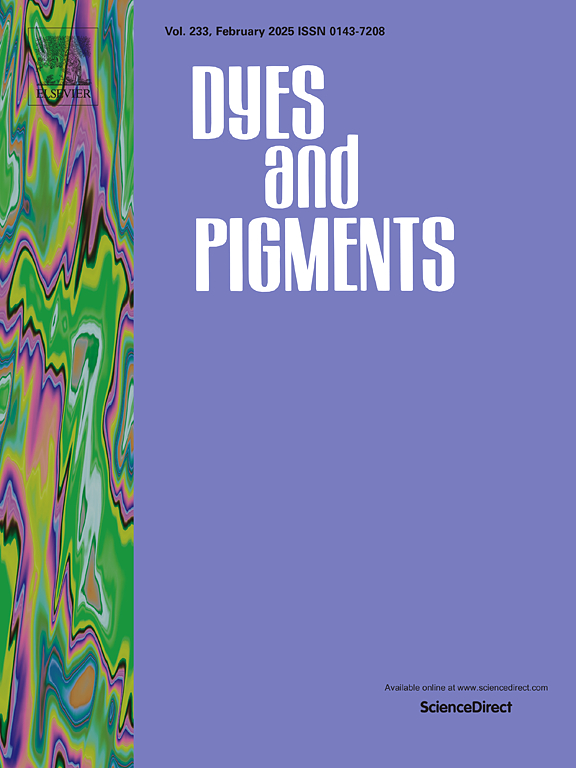通过铼(I)配位的萘吡啶的光致变色微调:对光致变色和发射开关的见解
IF 4.2
3区 工程技术
Q2 CHEMISTRY, APPLIED
引用次数: 0
摘要
本文报道了一系列铼(I)-吡啶取代萘吡喃配合物fac-[Re(N^N)(CO)3(NP)]PF6的合成、表征和光物理研究,重点研究了Re(I)配位如何精细调节萘吡喃(NP)配体的光致变色性能。此外,本研究描述了光致变色反应如何显著地实现了配合物发射行为的可逆光开关。Re(I)配合物很容易通过配体取代得到(收率为14 - 83%),并通过FT-IR, HRMS和NMR进行了充分的表征。吸收光谱显示,与NP前驱体相比,λmax发生了显色偏移,λmax值在356 ~ 386 nm范围内。在紫外线照射下,与NP前体相比,Re(I)配合物表现出显着增强的光致变色性能,包括从无色/淡黄色到黄色/橙色/红色色调的更快的颜色转变(λPSS = 422-500 nm),色移吸收带(6-18 nm),显着改善的光致变色性(高达~ 102倍)和加速的热漂白动力学。光致发光研究揭示了广泛的二亚胺(N^N)敏感发射带,峰值集中在442 - 577nm范围内,在光致变色激活后,可逆磷光猝灭高达79%。这些结果突出了Re(I)配位在精细调节萘吡啶的光致变色性能方面的潜力,为合理设计超快、高着色、可调的光致变色材料提供了令人兴奋的机会,这些光致变色材料可应用于眼科镜片、分子开关和智能材料。此外,Re(I)配合可以动态控制磷光,为光响应光子器件打开了有希望的可能性。本文章由计算机程序翻译,如有差异,请以英文原文为准。

Photochromic fine-tuning of naphthopyrans through rhenium(I) coordination: Insights into photochromism and emission switching
This study reports the synthesis, characterisation and photophysical investigation of a series of rhenium(I)-pyridyl-substituted naphthopyran complexes, fac-[Re(N^N)(CO)3(NP)]PF6, with a focus on how Re(I) coordination fine-tunes the photochromic properties of the naphthopyran (NP) ligands. Additionally, this study describes how the photochromic reaction notably enables reversible photoswitching of the emissive behaviour of the complexes. The Re(I) complexes were readily obtained via ligand substitution (yields = 14–83 %) and were fully characterised by FT-IR, HRMS and NMR. The absorption spectra revealed bathochromic shifts of the λmax compared to the NP precursors, with λmax values in the 356–386 nm range. Upon UV irradiation, the Re(I) complexes exhibited remarkably enhanced photochromic properties compared to the NP precursors, including much faster colour transitions from colourless/pale yellow to yellow/orange/red hues (λPSS = 422–500 nm), bathochromically shifted absorption bands (by 6–18 nm), significantly improved photocolourability (up to ∼102-fold) and accelerated thermal bleaching kinetics. Photoluminescence studies revealed broad, diimine (N^N)-sensitive emission bands with peak maxima centred in the 442–577 nm range, along with reversible phosphorescence quenching of up to 79 % upon photochromic activation. These results highlight the potential of Re(I) coordination to finely tune the photochromic properties of naphthopyrans, offering exciting opportunities for the rational design of ultrafast, highly coloured, tunable photochromes with applications in ophthalmic lenses, molecular switches and smart materials. Additionally, Re(I) coordination enables dynamic control of phosphorescence, unlocking promising possibilities for light-responsive photonic devices.
求助全文
通过发布文献求助,成功后即可免费获取论文全文。
去求助
来源期刊

Dyes and Pigments
工程技术-材料科学:纺织
CiteScore
8.20
自引率
13.30%
发文量
933
审稿时长
33 days
期刊介绍:
Dyes and Pigments covers the scientific and technical aspects of the chemistry and physics of dyes, pigments and their intermediates. Emphasis is placed on the properties of the colouring matters themselves rather than on their applications or the system in which they may be applied.
Thus the journal accepts research and review papers on the synthesis of dyes, pigments and intermediates, their physical or chemical properties, e.g. spectroscopic, surface, solution or solid state characteristics, the physical aspects of their preparation, e.g. precipitation, nucleation and growth, crystal formation, liquid crystalline characteristics, their photochemical, ecological or biological properties and the relationship between colour and chemical constitution. However, papers are considered which deal with the more fundamental aspects of colourant application and of the interactions of colourants with substrates or media.
The journal will interest a wide variety of workers in a range of disciplines whose work involves dyes, pigments and their intermediates, and provides a platform for investigators with common interests but diverse fields of activity such as cosmetics, reprographics, dye and pigment synthesis, medical research, polymers, etc.
 求助内容:
求助内容: 应助结果提醒方式:
应助结果提醒方式:


